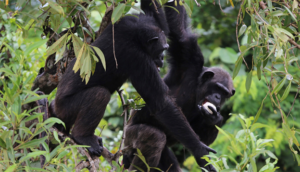Gregg Mitman
CURRENT PROJECTS
Research Grant
FRAGMENTS OF THE FOREST:
Hot Zones, Disease Ecologies, and the Changing Landscape of Environment and Health in West Africa
Why have certain regions, like West Africa, rich in biodiversity, also become identified as emerging disease hotspots in scientific and popular understanding? This European Research Commission Advanced Grant brings together an interdisciplinary team of researchers to discern the ecological, economic, political, and social forces at play that have turned fragments of the Upper Guinean rainforest in Liberia and Guinea into “hotspots” where biodiversity conservation concerns, emerging infectious disease threats, and resource extraction interests converge.
Bloodborne: Chasing Ecologies and Power Across Viral Divides
The fluidity with which viruses can cross the divides separating humans, nonhuman primates and other species proved vital to understanding the natural history of viruses and their control. In West Africa, where colonial resource extraction ushered in immense ecological, economic, political, and social change, flows of capital and building of infrastructure facilitated the search for viruses in the Guinean Forests, extending from Sierra Leone to Nigeria. The blood, viruses, insects, and wildlife specimens collected in this region became a foundation upon which Western
scientific understandings of viral infectious diseases and their ecologies were built and maps representing West Africa as a disease hotspot were made.
Nonhuman primates emerged as keystone species in the industrial ecologies of virus research and vaccine production. At the same time, viral exchanges posed threats to humans and their primate kin. Increasingly, policing and protecting the flow of viruses across species divides has become a driving agenda in the converging worlds of biomedicine, conservation, and animal rights. With a focus on three viral infectious diseases—yellow fever, hepatitis B, and Ebola—over a century of biomedical research in the Guinean Forests of West Africa beginning in the 1920s, this project explores how a new form of life, the virus, became known; how new scientific understandings of infectious diseases formed; how new alliances among living things were made; and how new health inequities took hold.
CURRENT PROJECTS

FRAGMENTS OF THE FOREST:
Hot Zones, Disease Ecologies, and the Changing Landscape of Environment and Health in West Africa
Why have certain regions, like West Africa, rich in biodiversity, also become identified as emerging disease hotspots in scientific and popular understanding? This European Research Commission Advanced Grant brings together an interdisciplinary team of researchers to discern the ecological, economic, political, and social forces at play that have turned fragments of the Upper Guinean rainforest in Liberia and Guinea into “hotspots” where biodiversity conservation concerns, emerging infectious disease threats, and resource extraction interests converge.

Bloodborne: Chasing Ecologies and Power Across Viral Divides
The fluidity with which viruses can cross the divides separating humans, nonhuman primates and other species proved vital to understanding the natural history of viruses and their control. In West Africa, where colonial resource extraction ushered in immense ecological, economic, political, and social change, flows of capital and building of infrastructure facilitated the search for viruses in the Guinean Forests, extending from Sierra Leone to Nigeria. The blood, viruses, insects, and wildlife specimens collected in this region became a foundation upon which Western
scientific understandings of viral infectious diseases and their ecologies were built and maps representing West Africa as a disease hotspot were made.
Nonhuman primates emerged as keystone species in the industrial ecologies of virus research and vaccine production. At the same time, viral exchanges posed threats to humans and their primate kin. Increasingly, policing and protecting the flow of viruses across species divides has become a driving agenda in the converging worlds of biomedicine, conservation, and animal rights. With a focus on three viral infectious diseases—yellow fever, hepatitis B, and Ebola—over a century of biomedical research in the Guinean Forests of West Africa beginning in the 1920s, this project explores how a new form of life, the virus, became known; how new scientific understandings of infectious diseases formed; how new alliances among living things were made; and how new health inequities took hold.
© 2019 Gregg Mitman


